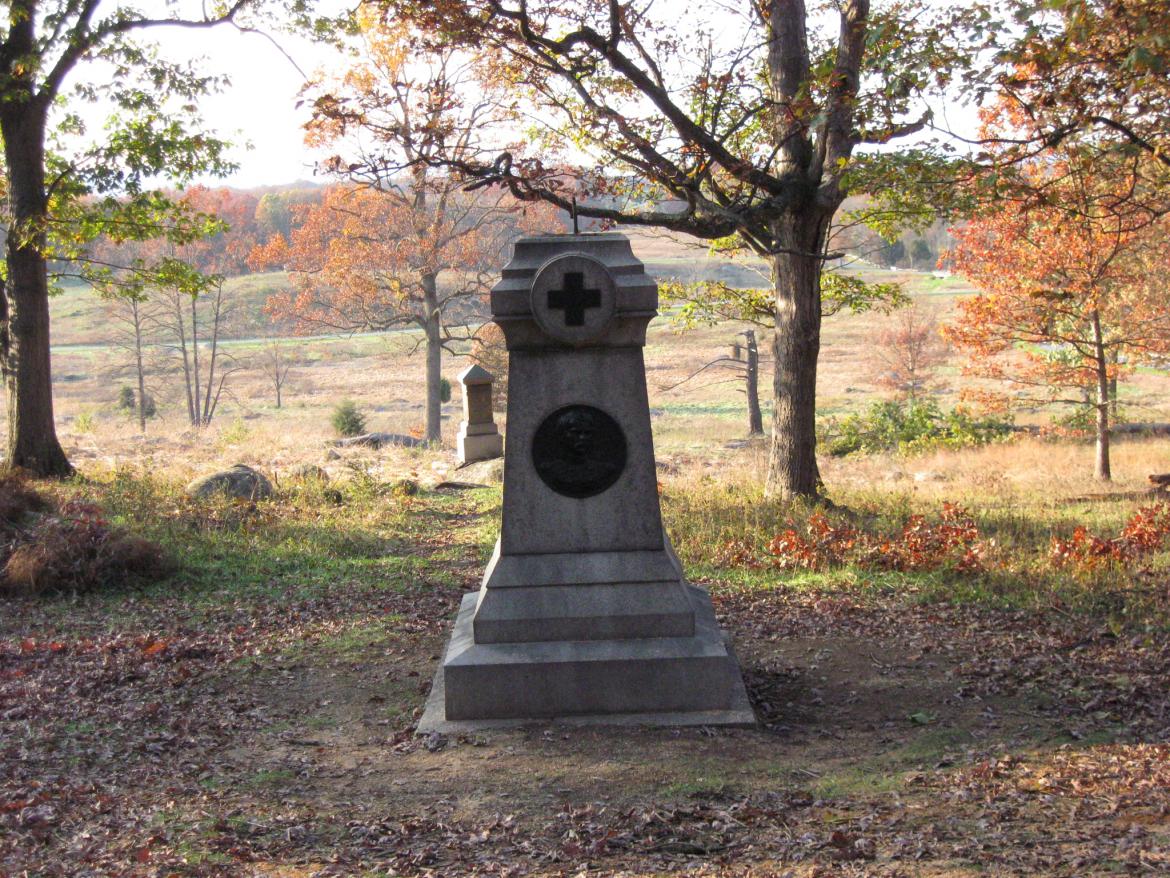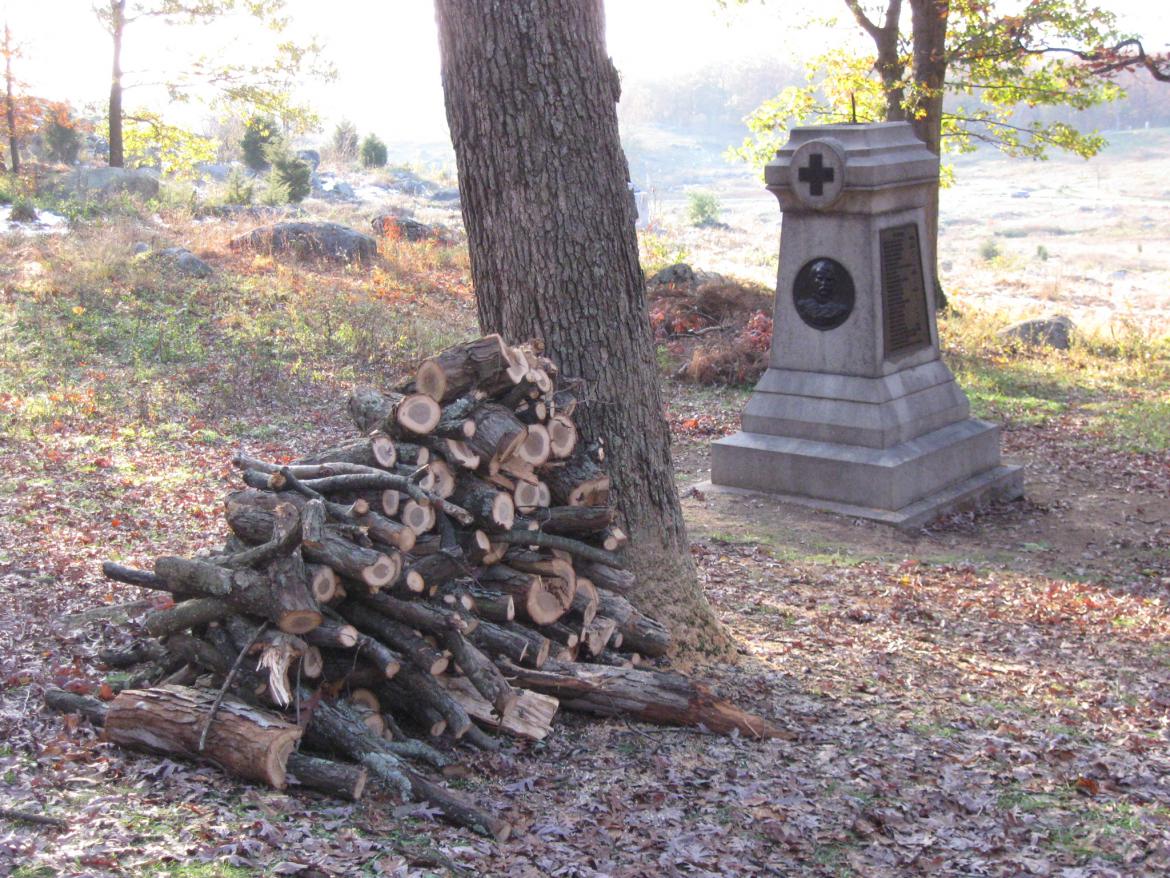The National Park Service has confirmed that the oak tree that fell on the cannon carriage near West Confederate Avenue was a “witness tree” to the Battle of Gettysburg. Their first e-mail to us informs us that it is the Pender Tree. We don’t know if it is THE Pender tree, as others have traditionally had that claim (please see our original witness tree post on which ones could have been considered to be the Pender Tree). However, it was close to where Brigadier General Dorsey Pender was mortally wounded in the thigh by a fragment of an artillery shell on July 2, 1863 (Pender died on July 18, 1863), and it witnessed Pickett’s Charge on July 3, 1863. During Pickett’s Charge, the Confederates left Seminary Ridge in the area of where the tree is located and marched across in the field in the background towards the Union lines on Cemetery Ridge. The Codori Barn is visible in the right center background. National Park Service spokesperson Katie Lawhon informed us that “Park staff estimated its (the tree’s) age by counting the rings. The tree is still in place near where it fell (Editor’s Note: By Saturday morning it was now on the other (west) side of West Confederate Avenue). The estimated age of the tree is 284 years. We may make a straight cross cut to recount and confirm that. And we may take a slice for the park’s collection. The Gettysburg Foundation has requested the wood for an art project they are doing with the Adams County Arts Council. The park will be providing the wood to the Foundation for that project.” This view was taken facing southeast at approximately 2:00 PM on Sunday, October 30, 2011.
Approximately five inches of heavy, wet, snow came to the Gettysburg area on Saturday, October 30, 2011. We followed up on the areas where the snow helped to topple a 284 year old witness tree on a cannon tube and carriage along West Confederate Avenue, and another tree damaged the 121st New York Monument on the north slope of Little Round Top.
To see our previous post on the damaged cannon and the damaged 121st New York Infantry Monument, see our post for October 31, 2011.
This map shows where the snow damage occurred that we are showing in this post. The red star with the “C” marks the location where the witness tree fell on the cannon along Seminary Ridge’s West Confederate Avenue. The star with the “121” shows where the tree fell on the 121st New York Monument on the north slope of Little Round Top. This image was taken facing north at approximately 4:30 PM on Sunday, October 30, 2011.
On Sunday when we arrived to take pictures of the tree that fell on the cannon, the artillery tube and carriage had already been removed from its location on Seminary Ridge’s West Confederate Avenue. The artillery piece was at the position of Crenshaw’s Virginia Battery. We wondered at the time about what looked to be a freshly made scar on the bark in the right center of this view. This view was taken facing south at approximately 2:00 PM on Sunday, October 30, 2011.
Here’s a closer view of the scar. We now understand that the scar was caused by falling on the cannon tube or the right (south) wheel of the carriage. This view was taken facing facing east at approximately 4:30 PM on Wednesday, April 30, 2008.
Notice where the right wheel of the cannon is positioned beneath the scar. National Park Service spokesperson Katie Lawhon informed us: “The carriage and tube have been taken from the field into park. The tube looks undamaged. Both wheels look like they can be re-used. The rest of the carriage will have to be rebuilt. The cannon carriage will be added into the stream of approximately 93 carriages that we have lined up for rehabilitation right now.” This image, courtesy of the National Park Service, was taken facing facing east at on Saturday, October 29, 2011.
So which one is the Pender Tree? And by Pender Witness tree, we mean the one by which he was standing when he was mortally wounded on July 2nd. The tree with the red star is the one that fell and damaged the cannon. Tree #2 is the front runner of being the Pender Witness Tree according to Gettysburg National Park Service Historian Kathy Georg. Georg informed Gettysburg Licensed Battlefield Guide Deb Novotny that the Pender tree was “the first tree NORTH of Pegram’s Battallion marker on the WEST side of the stonewall.” Other traditional stories have stated that Tree #3 was the Pender Witness Tree. This is the first time that we have heard that the tree that fell (with the red star) was the Pender Witness Tree. Of course all these trees would have “witnessed” the wounding. And is their real claim to fame being Pender Witness Trees or Pickett’s Charge Witness Trees? This view was taken facing southeast at approximately 4:30 PM on Wednesday, April 30, 2008.
We also revisited the monument to the 121st New York Infantry Regiment on the north slope of Little Round Top. The damaged bronze figure on the top of the monument has been removed to the maintenance area. A pile of wood, made up of some of the largest branches that damaged the bronze figure was waiting to be removed. This view was taken facing northwest at approximately 4:30 PM on Tuesday, November 1, 2011.
The monument to the 121st New York Infantry Regiment was dedicated on October 10, 1889. The smaller monument in front of (west of) the monument to the 121st New York is to the 98th Pennsylvania Infantry Regiment. It was dedicated on July 2, 1885. This view was taken facing northwest at approximately 4:30 PM on Tuesday, November 1, 2011.
Here’s what it looked like when the bronze figure was still attached to the granite base. This view was taken facing west at approximately 2:00 PM on Sunday, October 30, 2011.
National Park Service spokesperson Katie Lawhon e-mailed us that “The bronze figure was bent away from the pedestal about 30 degrees.” This view was taken facing west at approximately 4:30 PM on Tuesday, November 1, 2011.
National Park Service spokesperson Katie Lawhon also wrote: “The park’s monument preservation crew assessed the damage on Monday, October 31, and they have taken the life sized bronze infantryman from its pedestal and moved it to the park’s maintenance shop. The park’s monument preservation crew will be developing cost estimates to repair the cannon carriage and the 121st NY monument…I took this photo in the maintenance yard as the crew unloaded the figure from a truck onto some pallets.” This view, courtesy of the National Park Service, was taken by Katie Lawhon on Monday, October 31, 2011.
According to Katie Lawhon, “Preliminary information about the damage on the 121st NY monument includes…” This view was taken facing east at approximately 4:30 PM on Tuesday, November 1, 2011.
“…a bent pin where the bronze figure was attached to the stone pedestal…” This view was taken facing northeast at approximately 4:30 PM on Tuesday, November 1, 2011.
“…bent bronze on the base of the figure, and cracks in the bronze base…” This view was taken facing northeast at approximately 2:00 PM on Sunday, October 30, 2011.
“…We may have to cast a new bronze base in order to return the figure to its pedestal…” This view was taken facing northeast at approximately 2:00 PM on Sunday, October 30, 2011.
“…No cost estimates yet. Work to repair the monument will not begin until springtime.” This view was taken facing northeast at approximately 4:30 PM on Tuesday, November 1, 2011.
Here’s another view of the bent pin that attached the bronze figure to the stone pedestal. This view was taken facing northwest at approximately 4:30 PM on Tuesday, November 1, 2011.
And what happens to the wood stacked up near the monument? This view was taken facing west at approximately 4:30 PM on Tuesday, November 1, 2011.
National Park Service spokesperson Katie Lawhon informed us: “When park staff is cleaning up downed trees and branches, we sometimes cut up the wood for campfires for two purposes…” This view was taken facing southwest at approximately 4:30 PM on Tuesday, November 1, 2011.
“…1) Leave at the amphitheater for the evening campfire programs that are part of our summer interpretive program. Yes, there is actually a campfire at the campfire program…” This view was taken facing northeast at approximately 4:30 PM on Tuesday, November 1, 2011.
“… and 2) We provide firewood when possible at several locations in the park where our volunteer civil war living history units do encampments on most of the weekends from April through October.” This view was taken facing southwest at approximately 4:30 PM on Tuesday, November 1, 2011.
And if you think the wood is taken to any National Park Service structure for its employees to use in their fireplace, Katie Lawhon informed us: “There is no permitted use of the fire places in any of the historic homes owned by Gettysburg National Military Park.” This view was taken facing northeast at approximately 4:30 PM on Tuesday, November 1, 2011.
Dr. Pete Carmichael, who wrote a history of Crenshaw’s Artillery, now works at Gettysburg College. To order a copy of his book, click here. This image was copied facing north at approximately 4:30 PM on Sunday, October 30, 2011.
This image was copied facing north at approximately 4:30 PM on Sunday, October 30, 2011.
Emory Upton, who was a Colonel of the 121st New York during the Gettysburg Campaign wrote several books. For ordering information, click here.
This image was copied facing north at approximately 4:30 PM on Sunday, October 30, 2011.
This image was copied facing north at approximately 4:30 PM on Sunday, October 30, 2011.
























